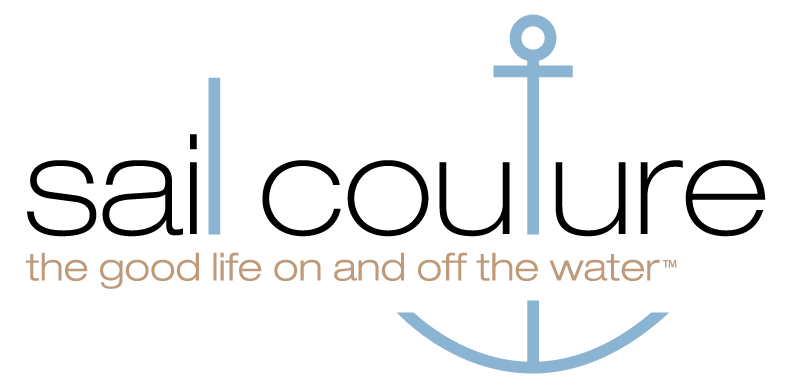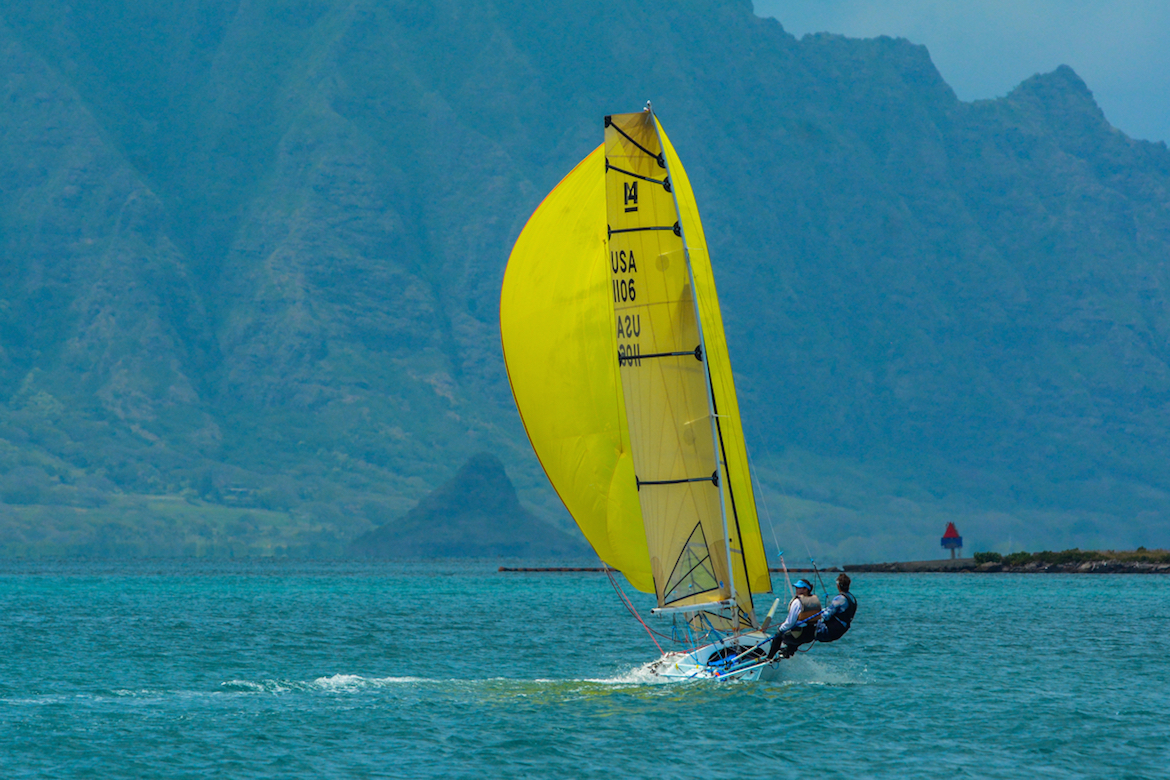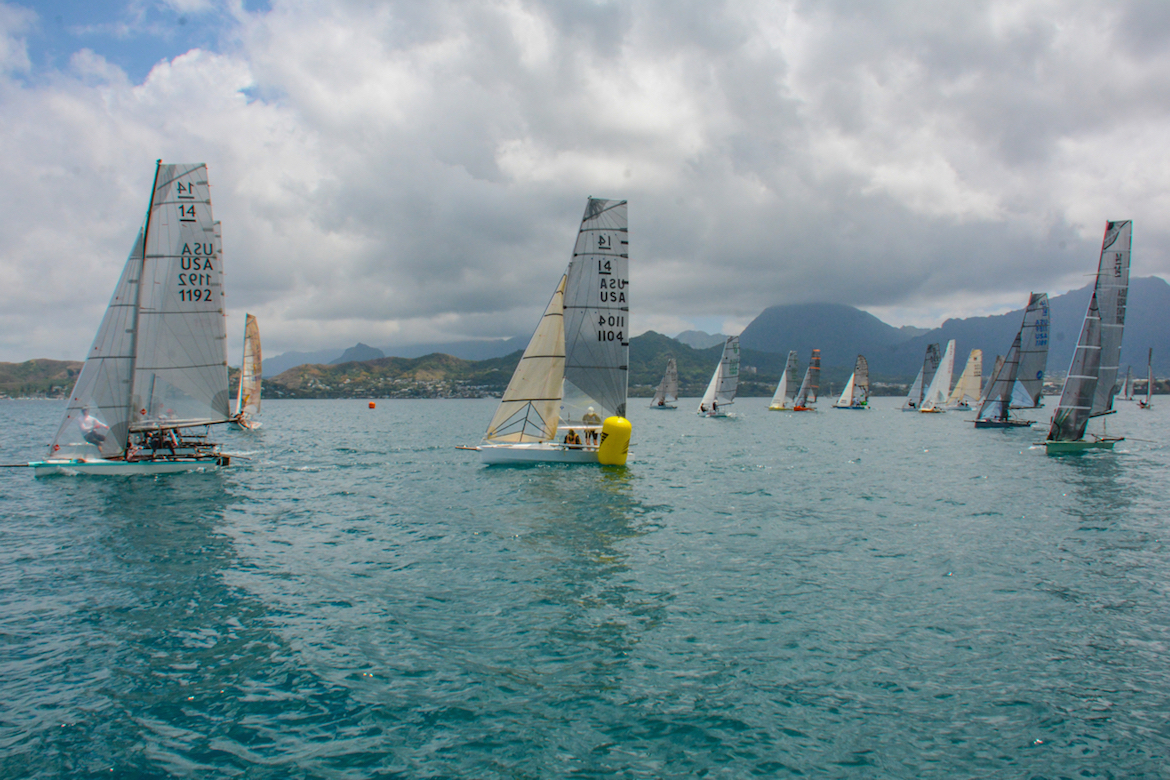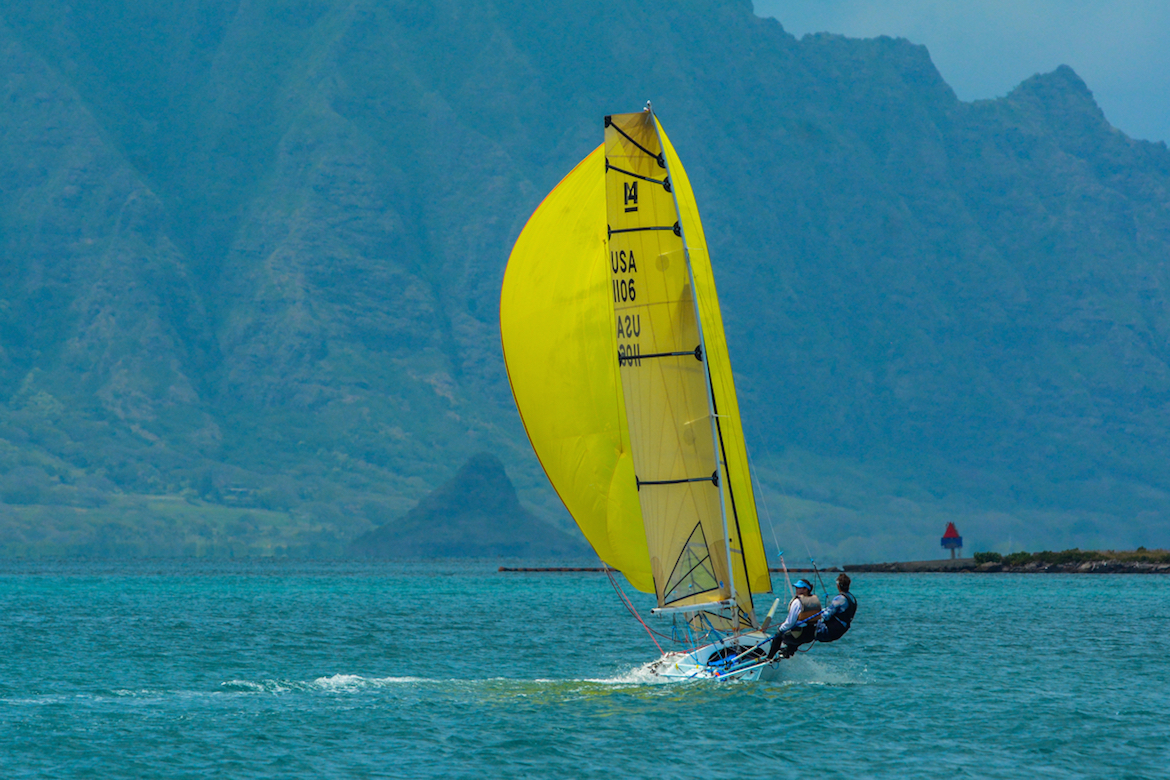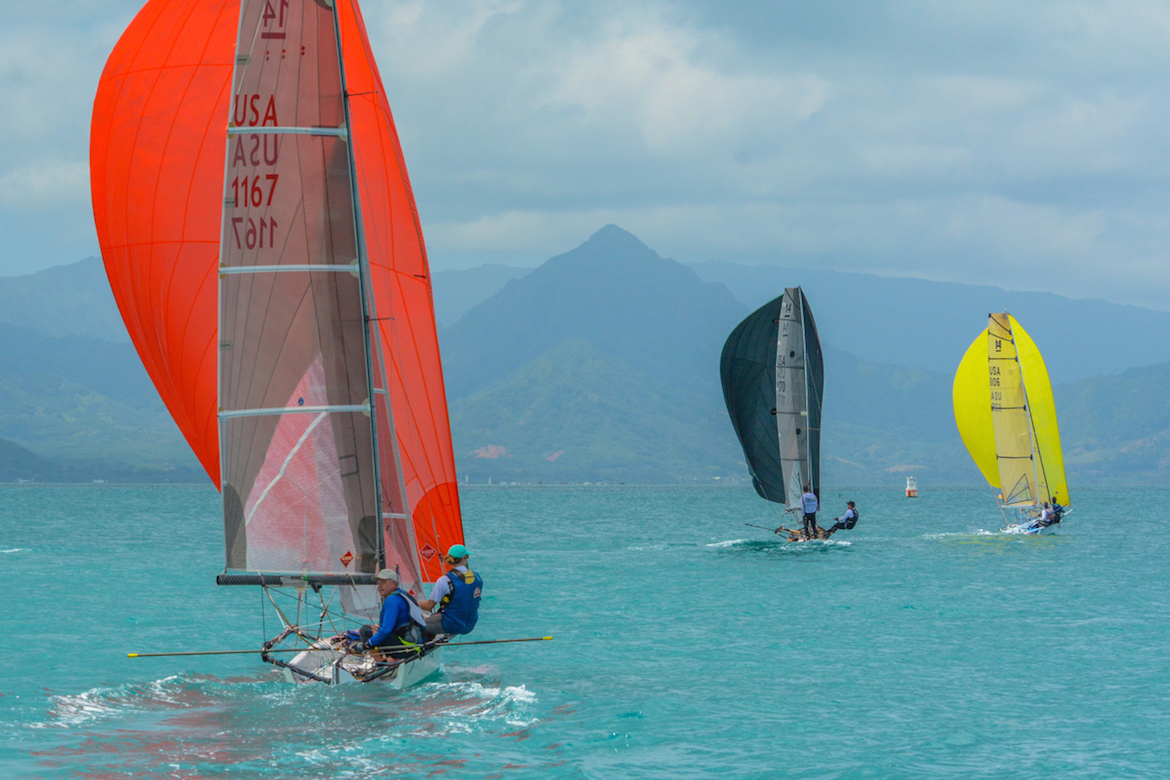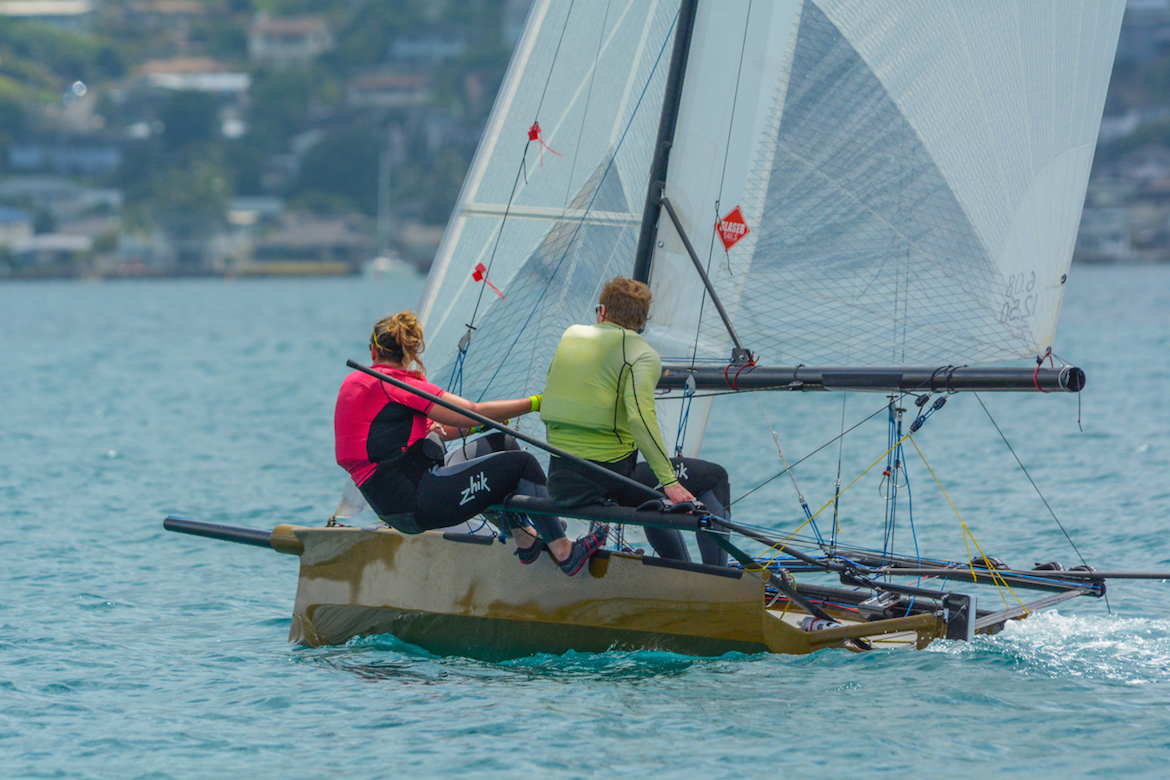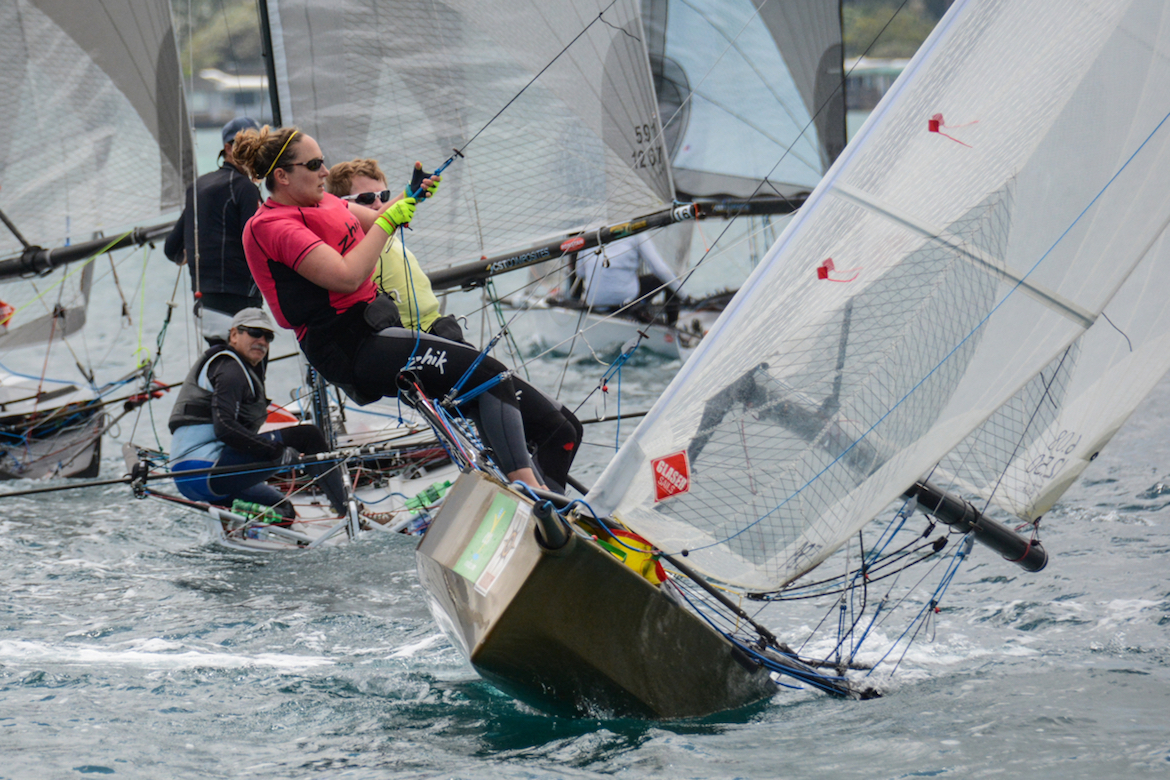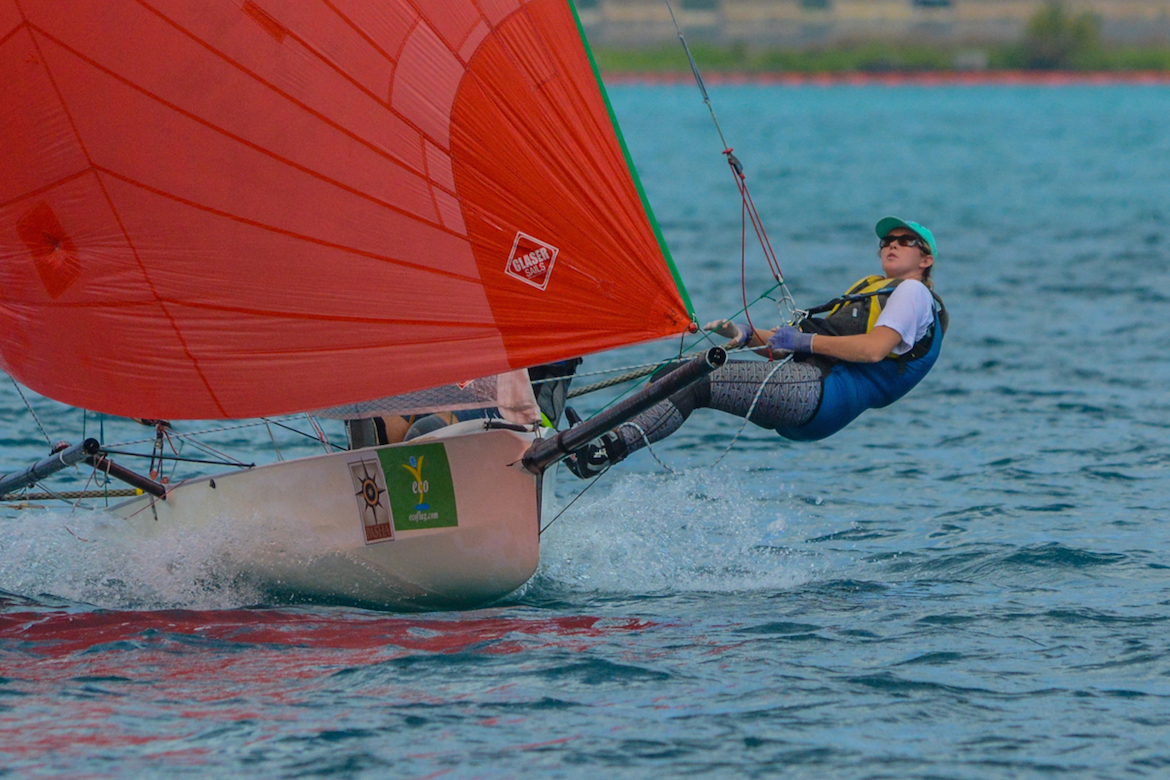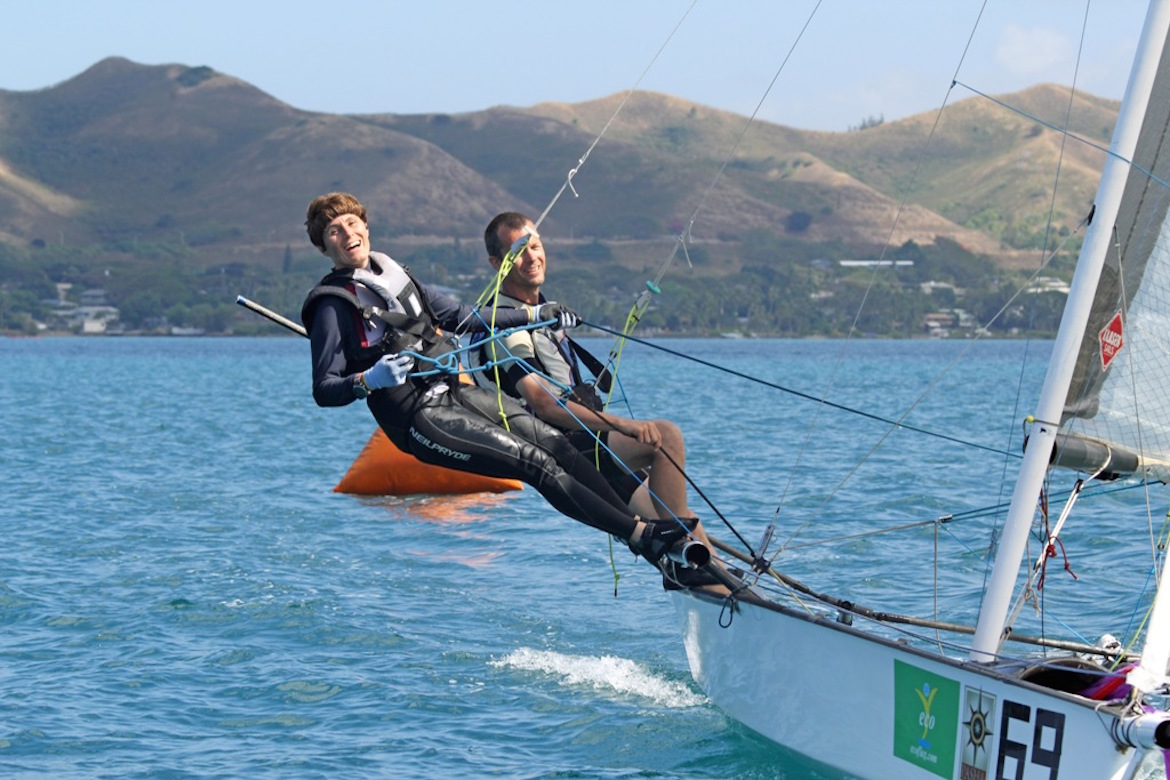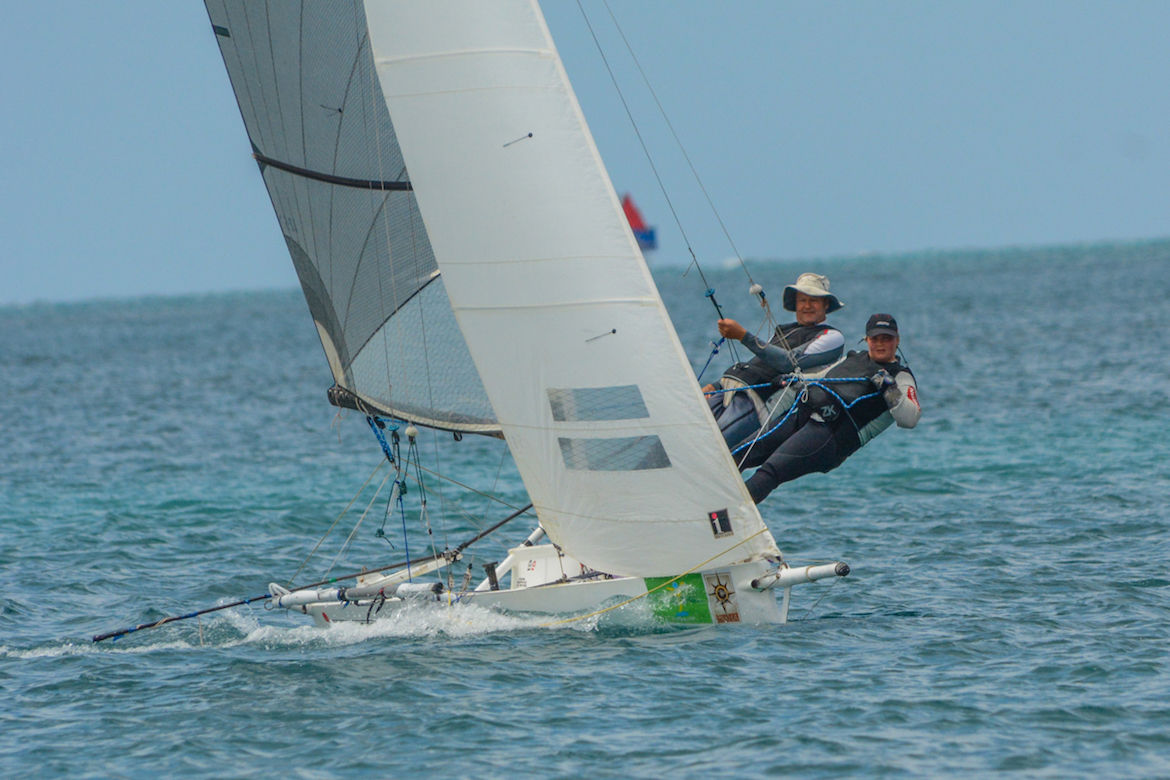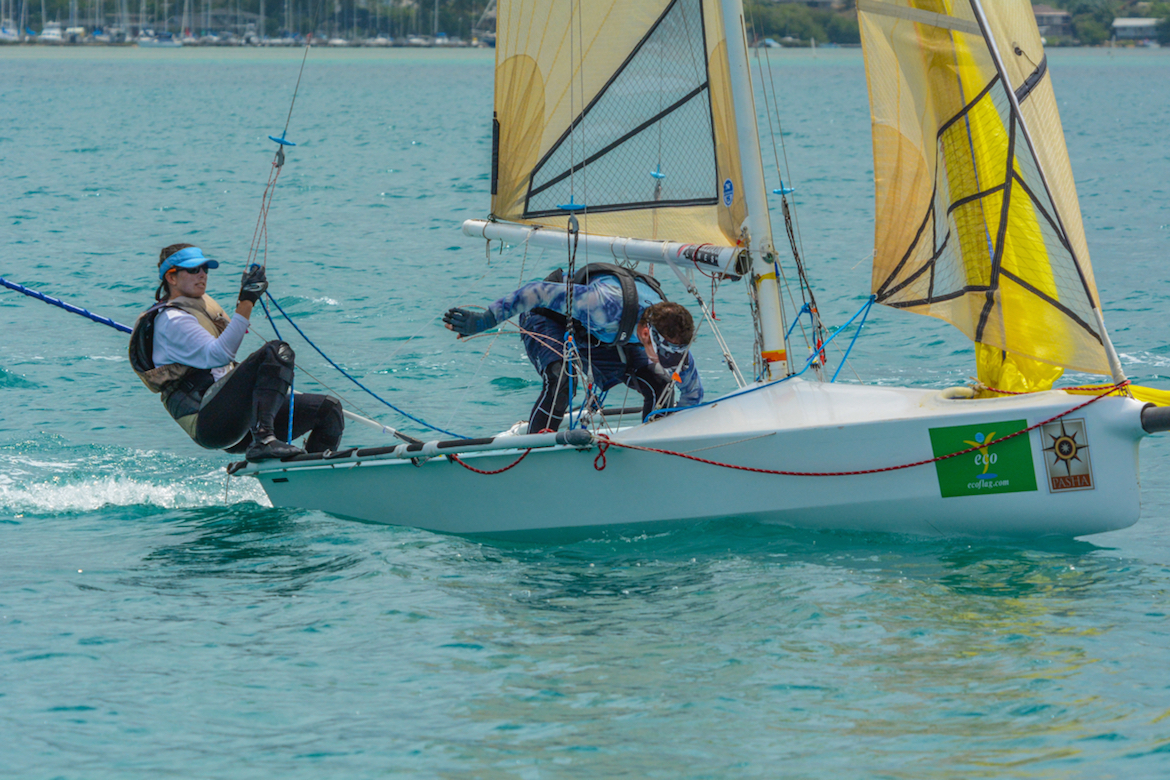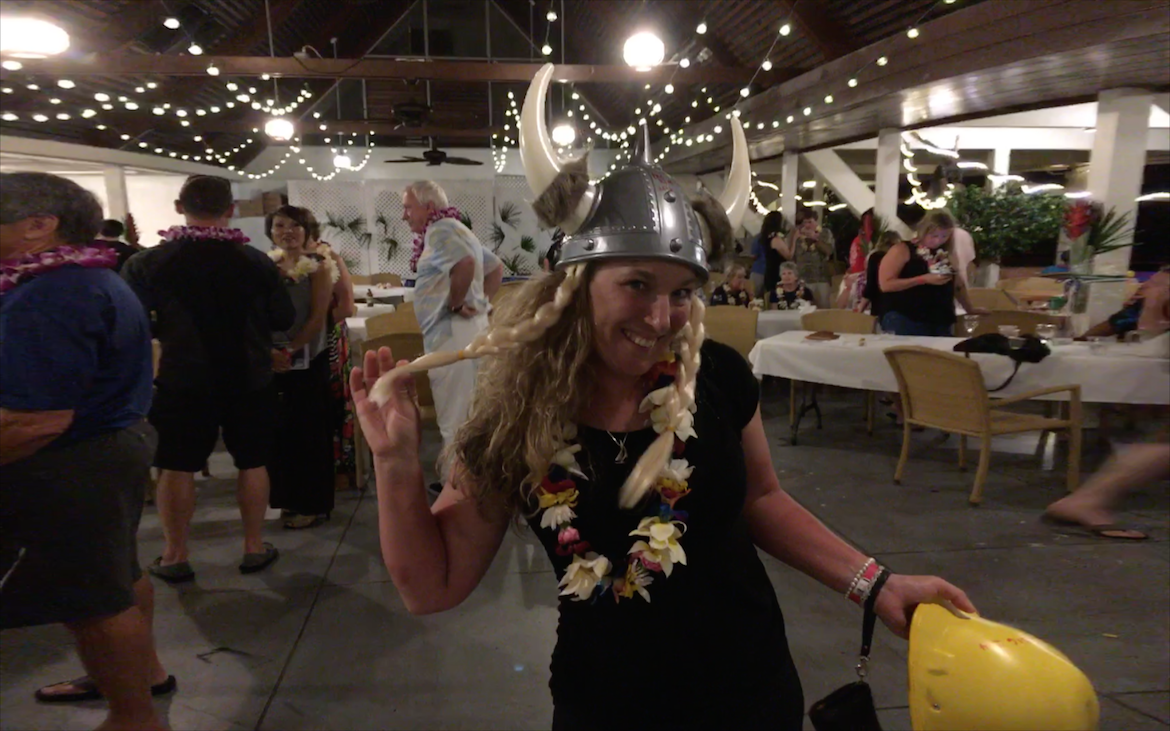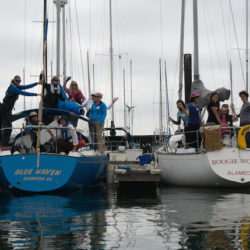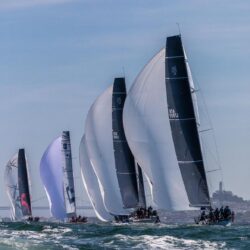They told me the I14 was a tough boat, but when the opportunity arose to spend a long weekend racing that sliver of carbon fiber on the sparkling turquoise waters of Oahu’s Kaneohe Bay, I was all in. That there would be a hand-carved Koa wood trophy for the first woman in the 2016 Pac Rim Championships was just a bonus.
The boats get off the start line on the first day of the 2016 Pac Rim Championships on Kaneohe Bay in Hawaii. Photo: Courtesy of Pasha Hawaii
Arriving in Hawaii, I meet my competition: Women from Australia, Italy, the mainland, and a couple of locals. The youngest woman was 23, the oldest, well, quite a bit older than that. Among my own friends and family, they think I’m pretty daring (and kind of crazy) for wanting to swing around on a skiff trapeze, not to mention that I’m a girl. In Hawaii, I met women of all provenances who are far more daring than I.
What is an I14?
For those of you that don’t know what an International 14 is (and I’m sure there are many—I had no I idea what it was until I saw one), it’s a 14-foot skiff, which is kind of like the very light jet of the sailing world (the HondaJet to Oracle’s fighter jet).
It has a mainsail, jib, and a huge masthead spinnaker. It’s sailed by two people, a driver and a crew, both wearing a trapeze harness, and more often than not, flying over the water on said trapeze, kite sheet in hand, ideally with one shoulder just a few inches from the water’s surface.
The I14 is not a one-design Olympic class boat like the 49er skiff; it’s a box design development class boat (kind of like the America’s Cup rule). That means that no two boats on the water are exactly the same. They can be customized and improved as much as one wants, as long as they don’t exceed certain parameters like a minimum hull weight and maximum mast height. Perfect for engineers and tinkerers.
Big breeze and flat water
We had been invited to Hawaii by long-time I14 fleet members and regatta organizers Andy and Maureen Bates, whom we knew from the 2015 Transpac race on Adrenalin. We’d been enticed out there by the promise of big breeze and flat water. While the breeze never fully materialized, the surface of the water was as flat as can be—very different from sailing on San Francisco Bay—and very warm. Which was good, because in my limited experience of skiff sailing, I don’t think I’ve ever dumped the boat over as many times in such a short amount of time.
Many competitors were drawn to Kaneohe Bay by the promise of big breeze and flat water, and the views weren’t bad either. Elise Leroux driving the boat with the yellow kite; Maddy Kennedy crewing on the boat with the red kite. Photo: Courtesy of Pasha Hawaii
The I14 isn’t my first skiff; I’d been sailing an RS800, which is a slightly less- powered-up and more forgiving one-design skiff very popular in the UK, on the San Francisco Bay for almost four years when I got the news that my skiff partner had traded up for a new I14.
The author, sailing on a brand new Bieker 6 built by Kris Henderson in Seattle. Photo: Courtesy of Pasha Hawaii
The boat, a shiny new Bieker 6 built by Kris Henderson, arrived in San Francisco on a truck from Seattle one early January morning. We’d only sailed it twice before it had to be packed up and loaded into a Pasha Hawaii container.
For the author, keeping the boat upright is a full-time job during the chaos of the start. Photo: Courtesy of Pasha Hawaii
We got to Kaneohe Bay the Thursday before the weekend regatta. We sailed an hour or so that first evening after putting the boat together, and almost four hours on our second practice day. By the time we got off the water on Friday afternoon, I was dehydrated, bruised, and had a huge blister tearing across the palm of my left hand.
And I still had four days of actual racing to go.
I’ll admit, the thought did cross my mind at least once that evening… Why did I want to do this again?
The competition
I wasn’t the only woman new to the I14s that weekend. Freya Vickery says she’s been to just about every single I14 regatta since she was born—23 Australian nationals and six worlds—but it was the first one she got to race in.
Freya Vickery crewing for her father Stewart on USA 1160. The Vickeries are Australian, but sailed a charter boat in Hawaii. Photo: Courtesy of Pasha Hawaii
“I told my dad in Toronto, I’ve had enough of this. I’m sick of sitting on the sidelines, I want to get involved,” she recalls. She grew up sailing a range of dinghies: optimists, 420s, 29ers, Hobie 16s, and a B14.
“My dad was so happy, I think he’s been waiting his whole life for me to say that.”
She raced in Hawaii with her dad who is 61 and has been sailing since he was 20.
“He loves his I14 sailing!”
Maddy Kennedy, a recent graduate of the University of Hawaii, is even newer to the boat. “I’m a sailing instructor at the yacht club. Andy [Bates] found me one day and he needed a crew.” Maddy grew up in Minnesota sailing dinghies and raced FJs in college, but she says the I14s are a lot more fun. “I’m hooked.”
Simona Saccani, a native of Italy who lives in France and now sails out of the U.K. was the veteran of the fleet in Hawaii, at least on the women’s side. She’s been sailing I14s since 2000, when her boat partner Dominic Van Essen, decided to start a new fleet on Lago Maggiore in Ascona, Italy. “He had recruited a bunch of people, we were all working together in the same institute as scientists. So we built up a mini fleet over there.”
Elise Leroux was the veteran female representative from Hawaii. A native mainlander, she says the “short version” of the story is, she visited for a week in the late 1990s, and pretty much never left. In 2004, she was doing bow on a Farr 1020 when a rival bowman said, “Hey, I just bought this great boat…”
“I came out one weekend to sail with him. We did a lot of swimming, but we had some great rides,” she recalls. “We sailed together for a year until he left town. No one needed crew, so it was either buy the boat or stop sailing I14s.” Elise bought the boat.
There were a couple of other women in the regatta with similar stories: My husband really wanted a 14; my dad grew up sailing them and now so do I. It seems that in just about every case it was a man who dragged these women into this boy’s club. I started to wonder, why?
“I guess the guys, somehow, they like the women around,” says Simona. “They treat us like little princesses. I like women, but I don’t like girlies. To be with the men is easy, and the other girls that are around, they’re like me, so it’s perfect.”
I believe I can fly…
So what’s the attraction of I14 sailing? Well, first of all, there’s that aspect of flying.
“When you’re flat on the wire and you’re in control, you feel like you’re flying,” says Italian I14 sailor Simona Saccani. Photo: Kai Andrade
“The excitement that you have sailing downwind—you don’t have that with other boats. You go so fast, it’s so amazing. When you’re flat on the wire and you’re in control, you feel like you’re flying,” says Simona.
The I14 is a very narrow boat with a very tall mast, proportionally. So even in light breeze, at least the crew can generally be out on the trapeze.
Freya told me that sailing in Australia is a lot like sailing in San Francisco Bay, with big breeze and huge chop. Sometimes you’re really knocked around. In Hawaii, the flat water makes sailing feel as smooth as a summer breeze. The I14 can plane in as little as eight knots, and sailing it feels like skimming across the surface of a bed of silk.
“I love the flat water. The flat water is amazing. I’m so glad to get this chance to sail at this magical place,” says Freya.
To drive or crew
It’s commonly understood that the best configuration for a mixed crew to sail a skiff or small catamaran, is for the man to crew and the woman to drive, which I suppose leverages masculine strength and feminine finesse. My skiff partner and I have always known we were doing it “wrong” since he drives and I crew, but in sailing, for me, there’s nothing better than trimming the kite and he likes to drive.
In Hawaii, I was surprised to discover that just about all of the women were crew. “Dad wants me to crew because he can’t crew,” says Freya. “It gets pretty hectic skippering, but hopefully one day I’ll get into it.”
Elise was the only driver. When she bought her own boat, she had two other women, Maureen Bates and Heather MacCafrey, come out to crew for her. “They took a beating because I was not very good, but we had a great time and I still love doing it.”
Simona on the other hand, says she prefers to crew. “I get too stressed when we go downwind, I don’t feel good to drive the boat. We tried to switch, but for me it’s much more stressful. I feel relaxed if I have the main and do the hard jobs.”
I would tend to agree. As long as you can trust your driver, crewing is the much more physically demanding, but far less stressful position. However, I wasn’t the only one to mention how tired I was at the dock.
“I think after yesterday I don’t know if there’s a time I’ve been more tired after a regatta. The four-lapper—it was about all I could do to get the kite up and back down,” says Maddy. And then she hastily adds, “I’d definitely do it again though.”
It’s not all work
Even more than the smooth water and the chance to fly, everyone told me that what keeps them in the class is the welcoming community.
Left to right: Elise Leroux says one of the things she loves about the I14 community is how supportive everyone is, but on the water, it’s every sailor for herself!; Group shot of regatta participants after the boats were packed back into the Pasha Hawaii containers for the trip back to the mainland; the I14s enjoyed four days of spectacular racing on Kaneohe Bay. Photos: left and right courtesy of Pasha Hawaii, center:Maureen Bates.
“I love the 14 fleet because it’s just fantastic—young and old, we’re all partying together. I went backpacking around the world and camped at every 14 sailor’s house around America and Germany. It’s just a really good fleet to get involved with,” says Freya.
And it’s not just partying—the fleet truly wants to help newcomers get started.
“It’s a really supportive fleet. Both this whole group here and locally. If I need help fixing my boat, there are people willing to help me or give me advice,” says Elise.
In Europe, Simona says the atmosphere is similar. “The class is really welcoming in general. You feel easy. Everybody’s helping, it’s a nice atmosphere. It doesn’t matter your level, you have your own race within the big race. We are at the bottom of the fleet, but we have fun anyway.”
A personal trophy
I didn’t win the hand-carved Koa half-model; Freya did, and it was a job well done. I did get my own trophy in the roast though, a Viking helmet from our host Andy Bates for being the “toughest girl in the race.” I was purple polka-dotted by the end from climbing back in after we’d capsized the boat, and I’m not going to lie, there were a few times, like when sailing to a mile marker out in the ocean along a reef that just happens to be one of the largest breeding grounds in the world for hammerhead sharks, I was pretty terrified.
The author won the “Viking Award” for being the toughest crew in the regatta during the post-race roast. Photo: Maureen Bates
But would I do it again? Definitely.
And not just because flying on a trapeze along turquoise water under a clear blue sky is an experience to be repeated as many times as possible, but for the chance to hang out with this incredible group of women, our own fleet within the fleet.
